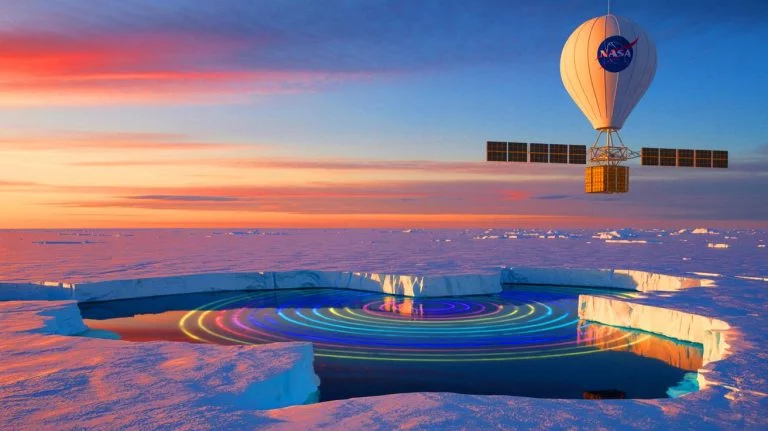| IN A NUTSHELL |
|
In a world filled with scientific enigmas, the recent detection of unusual radio signals emanating from beneath the Antarctic ice has captured the curiosity of researchers and enthusiasts alike. These signals, detected by NASA’s Antarctic Impulsive Transient Antenna (ANITA), challenge our understanding of particle physics and cosmic events. Traditionally, ANITA captures radio waves from cosmic phenomena, but these particular signals, which emerged between 2016 and 2018, originate from below the icy surface. This unexpected discovery has led to a flurry of hypotheses and scientific analyses, sparking a renewed quest for answers in the realm of physics.
Decoding the Mysterious Radio Signals
The unexpected radio signals detected by ANITA have posed a significant challenge to the scientific community. Typically, ANITA captures radio waves that originate from above, but these anomalous signals were traced back to beneath the Antarctic ice. This suggests that they traveled through thousands of miles of bedrock, a journey that should have absorbed their energy. Researchers initially hypothesized that these signals might be linked to neutrinos, subatomic particles known for their ability to pass through matter without interaction. However, the characteristics of the signals did not match typical neutrino interactions, leading scientists to explore alternative explanations.
Despite intensive data analysis and comparisons with mathematical models, the origin of these signals remains elusive. Other detectors like the IceCube and the Pierre Auger Observatory were cross-referenced, but they did not capture similar phenomena. This discrepancy further complicates the task of identifying the source of these signals and underscores the need for more advanced detection technology.
The Role of ANITA in Cosmic Exploration
ANITA, a sophisticated suite of 24 radio antennas attached to a NASA balloon, is a critical tool in the study of cosmic events. Operating at an altitude of 25 miles above Antarctica, it is strategically positioned to minimize interference from other radio signals. ANITA’s primary mission is to capture radio waves generated by cosmic events, providing insights into high-energy processes occurring in the universe. The choice of Antarctica for this mission is crucial, as the region’s unique conditions offer a clear vantage point for detecting these elusive signals.
One of ANITA’s primary objectives is to detect neutrinos, particularly tau neutrinos, which are known for their interactions with Antarctic ice. These interactions result in phenomena known as ice showers, where secondary particles like tau leptons release distinct radio wave bursts. ANITA’s ability to capture these bursts provides valuable data for understanding cosmic events and the behavior of subatomic particles across vast distances.
Challenges and Future Prospects in Particle Physics
The detection of these enigmatic radio signals highlights the challenges faced by researchers in the field of particle physics. Despite advancements in detection technology, the inability to trace these signals to known sources underscores the complexity of cosmic phenomena. The scientific community is now looking forward to the launch of the Payload for Ultrahigh Energy Observations (PUEO), a next-generation detector designed to provide deeper insights into these anomalies.
The findings published in Physical Review Letters represent a significant step forward in our understanding, yet they also emphasize the limitations of current technology. As researchers continue to probe these mysteries, the development of more powerful instruments will be crucial in unraveling the secrets of the universe and enhancing our comprehension of fundamental physics.
The Unending Quest for Knowledge
The pursuit of understanding these mysterious radio signals is a testament to the relentless spirit of scientific inquiry. As researchers delve deeper into the data, they are driven by the belief that each anomaly offers a potential breakthrough in our comprehension of the universe. The collaboration between various scientific institutions highlights the importance of collective efforts in solving complex problems.
As we stand on the brink of new discoveries, the question remains: What other unknown cosmic phenomena are waiting to be uncovered, and how will they reshape our understanding of the universe? This open-ended inquiry invites us to continue exploring the vast cosmos with curiosity and determination.
Did you like it? 4.4/5 (23)







Is this real life or a sci-fi movie? 🤔
Thank you for the insightful article! It’s fascinating how much we still don’t know about our own planet.
Are these signals a sign of alien life? 👽
Wow, just when you think science can’t get any weirder.
Why isn’t this bigger news? Seems like a HUGE discovery!
How do they know the signals came from below the ice and not above?
Maybe it’s just a giant ice radio that’s finally warmed up enough to start working again! 😂